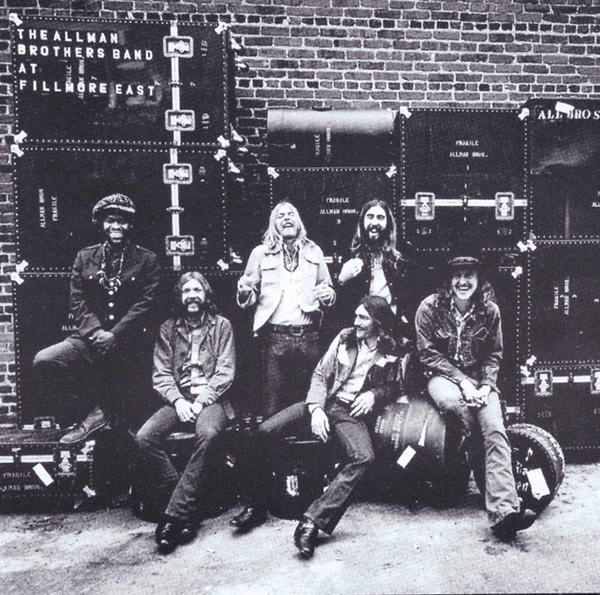Recreate Georgia's Most Iconic Album Covers
Long before Georgia was a hotbed of scenes straight off movie sets, you had musicians inspired enough by the surrounding Southern landscape to incorporate these places into their album art. These local ties gave the music -- and these backdrops -- an even great sense of place.
So, grab those LP sleeves and a full tank of gas and travel around Georgia to recreate some of music’s most iconic albums.
The Allman Brothers
Macon remains the launchpad of the Allman Brothers, and that brotherhood was deeply rooted in the soul of Macon. To prove it, look no further than two of the bands’ most prolific albums.
The Allman Brothers Band (1969)
Their 1969 self-titled debut (with photos taken by Stephen Paley) featured the band on the porch of an aging Greek revival mansion, where the peeling paint and tangled vines on the stately columns screamed old South and a new era of integrated Southern music. Today, that very same site was revived as the Robert McDuffie Center for Strings, the world-renowned music conservancy founded by international violin virtuoso (and Macon native) Robert McDuffie and part of Mercer University’s Townsend School of Music. Gone are the peeling paint and vines, but the grand dame columns and porch still overlook the lot where the band’s first apartment was once located.
This iconic site is marked with a music history plaque and welcomes visitors to take pictures. Take a Rock Candy Tours’ “Rock n’ Roll Stroll” and your tour guide will whip out the actual album cover, so your group can properly recreate the swaggered poses of Gregg, Berry, Jaimoe, Duane and Butch and hear lively stories about the location.
It’s also worth noting that the back cover of this album was shot at Macon’s historic Rose Hill Cemetery, directly behind the Bond Monument and down the stairs toward the train tracks. No visit to Macon is complete, especially when tracking the Allman Brothers, without a visit to Rose Hill, where the band members wrote songs about its memorials and later returned to lay their fallen band mates to rest.
At Fillmore East (1971)
Further down the road, into downtown Macon’s commercial district, you can find the very same alleyway used as the backdrop of the Allman Brothers’ "At Fillmore East" album. There has been much debate on where the exact spot was located, but the site is now confirmed as a block away from the Capricorn Records’ studio, where the band once stored their equipment.
The story behind this iconic shot by Jim Marshall includes some rock n’ roll mischief (check out Alan Paul’s 2014 book "One Way Out: The Inside History of the Allman Brothers Band" if you want the full story). The original building behind them was demolished, but you can follow the matching concrete road to the site (or ask Rock Candy Tours to take you there). However, if you really want to do the photo right, visit the Allman Brothers Band Museum at The Big House, where you can recreate the entire scene, road cases and all, in the Big House’s fun photo opp found on the museum’s property.
R.E.M
Murmur (1983)
Another debut album, and arguably one of the best, R.E.M’s "Murmur" whispered of a Southern Gothic new wave and had the album art to back it up. The stark front photography by Sandra Lee Phipps featured a mess of kudzu overtaking a train station. The back features the remnants of an old train trestle, a piece of a railroad that linked Athens to Augusta and dates back to 1883.
Fill up on Southern vittles (ask for the Automatic!) at Weaver D's and walk it off to Dudley Park, where you can stand among what is lovingly referred to as “Murmur Trestle.” You can also enlist Athens’ official music historian, Paul Butchart, to guide you there through Historic Athens Tours.
Jerry Reed
Cookin' (1970)
Grab a guitar, find a quiet spot along North Georgia's Etowah River, and recreate Jerry Reed’s 1970 cover to "Cookin’." The 11-track album wasn’t a hit-maker, but his experimental title track, “Cookin',” landed the country artist on the pop charts.
Although this album cover was shot by Jimmy Moore on the banks of Tennessee's Cumberland River, Reed's connection with rivers runs deep, as a child who was raised by family members in Rockmart, Georgia. The Etowah River and surrounding lakes and streams is where a guitar-wielding Reed was also known for his fishing rod.
The story behind the album cover is that while Reed was fishing on the Cumberland River, Felton Jarvis contacted him for advice on achieving Reed's fingerpicking guitar sound on Elvis Presley's cover of his "Guitar Man." Reed told Jarvis they would have to hire him for that sound. A simple call turned into Reed playing on Elvis' recordings of "Guitar Man," "U.S. Male," and "Too Much Money Business."
Ludacris
Chicken-n-Beer (2003)
Remember that time Ludacris was about to take a bite out of a shapely gam on the cover of his "Chicken-n-Beer" album? Well, you can’t entirely recreate his fourth studio album, released in 2003, but you can get a taste of it. And if you order enough wings and beer, you’ll come close.
Find Ludacris’ namesake Chicken + Beer restaurant in Atlanta’s Hartsfield-Jackson International Airport, located in Concourse D, near Gate D5. The full-scale restaurant seats 90 people and features enough Southern-style comfort food, locally sourced beer, and “Luda” touch to give you the album cover experience you crave, 15 years later and much more Chris Bridges refined.








